The defeat of the Kwantung Army - a sample of genuine lightning war
At the same time, special units carried out an enormous amount of work to restore the railway tracks. Our railroad workers quickly established traffic at the stations of Manchuria-Hailar, Halun-Arshan-Taoan. This allowed us to improve the supply and movement of our troops, strengthened their rear communications.
Development offensive. Trans-Baikal Front
The troops of the Trans-Baikal Front, having entered the Manchurian Plain, launched an offensive in the southeast direction. The focus was on the Mukden direction. The task of capturing Mukden was solved by the 6-I Guards Tank Army. 39-I army attacked Changchun and Siping. 36-I army had to go to the area of Qiqihar, Taylay and Anguang. To close the gap that was formed during the offensive between the 6 Guards Tank Army and the right-flank 17 Army, the front command used the second echelon, the 53 Army. The 53 Army had to reach the Kyle area and continue to attack Fuxin and the coast of Liaodong Bay.
The 16-17 of August, the units of the Horse-mechanized group took the city of Zhangbei and began to develop an attack on Kalgan. In the city of Changbei, two divisions of Prince Devan (troops of Inner Mongolia) with their headquarters and all armaments capitulated. The troops of the 17 Army took Chifin. 19 August KMG troops came to Rehe.
The pace of the offensive of the Guards Tank Army fell. Tanks and vehicles consumed fuel, stuck in the mud and more often broke, fell behind. People went for days without bread and hot food. From the city of Tungliao to the southeast, tankers moved along the railroad track, as the showers blurred all dirt roads.
The troops of the 39 Army were concentrated in the Taoan region for the development of an offensive in the southeast direction. Part of the army continued to fight to eliminate the remnants of the previously defeated garrison Halun-Arshansky fortified. On the night of August 16, advanced units of the army repulsed six enemy counterattacks northwest of Solun, each participating before the enemy battalion. The 221 Rifle Division of the 94 Corps 70 kilometers north of Vanyemiao (Ulan-Khoto) fought hard against the 107 Japanese Infantry Division. Only by 30 in August, the Japanese group was destroyed, its remnants capitulated. More than 7300 Japanese surrendered. Later on, the 39 Army was transferred by rail to Port Arthur. The left-flank 36-i army part of the forces completed the destruction of the remnants of the garrison of the Hailar SD, and the main forces attacked Qiqihar.
Thus, the troops of the Trans-Baikal Front entered the central regions of Northeast China. The right wing of the front has established contact with the forces of the People’s Liberation Army of China. The remnants of the Kwantung Army were cut off from the Japanese troops stationed in Central China.
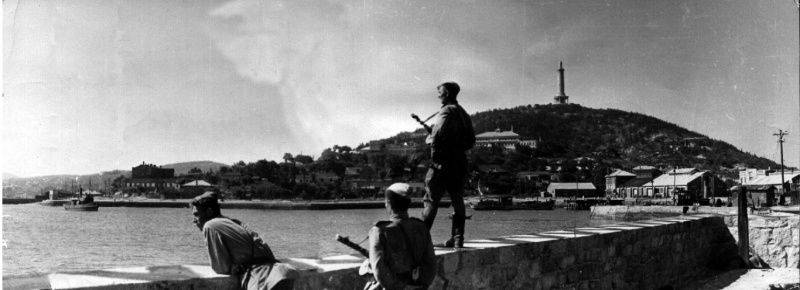
Soviet soldiers captured in Port Arthur
1 Far East Front
From the east, the troops of the 1 Far Eastern Front entered the central regions of Manchuria. The right-flank 35 Army of August 17 captured the city of Boli, where 2 was captured by thousands of Japanese soldiers.
The offensive developed in the main (Mudanjiang) direction. The enemy group in Mudanjiang was half-encircled. The 1-I Red Banner Army advanced from the north, the 5-I Army advanced from the east. The command of the 26 Infantry Corps decided to attack the enemy from two directions. The 22 Rifle Division, forcing the Mudanjiang River into 10-12 kilometers north of the city, was to capture the northwestern part of the city; The 300 Rifle Division with the 257 Tank Brigade - the eastern and southeastern part of Mudanjiang.
On August 15 from the area north of Mudanjiang, the 300 Division launched its offensive. She was supported by another tank brigade - 77. In the evening of the same day, the 22 Infantry Division began to force the river using improvised means. By the morning of August 16, Soviet troops were concentrated on the left bank of the river and were ready to continue the offensive. In the morning, the 26 Corps resumed its offensive. The Japanese infantry, relying on the support of artillery and a serious system of fortifications, put up fierce resistance. However, the onslaught of our troops was so powerful that the Japanese could not resist. The 300 Division, with a two-tank brigade, took Echo station 5 kilometers east of Mudanjiang and proceeded to force the river. Meanwhile, the 22 Division, breaking through the city’s defenses on the outskirts of the city, broke into Mudanjiang from the northwest. Fearing complete encirclement, the Japanese troops began to retreat. This took advantage of part of the 300 th Infantry Division, which by means of improvised means crossed the river and entered the city.
As a result, the 26 Corps took Mudanjiang, a large industrial center and communications hub. The city of operational and strategic importance, which covered the way to the central regions of Manchuria from the east, was taken. The main forces of 5 of the Japanese army, defending the area, were defeated. Lieutenant-General Shimizu Noritsune, commander of the 5 Japanese Army, said: “We didn’t expect the Russian army to go through the taiga, and the Russian offensive from hard-to-reach areas was completely unexpected for us. The loss of the 5 Army amounted to more than 40 thousand, that is, about 2 / 3 of its composition. The army could not resist further. No matter how we strengthened Mudanjiang, it was not possible to defend him. ”
On the morning of August 16, the troops of the 5 Army went on the offensive. They broke through the enemy’s long-term defense east of Mudanjiang and reached the city. After that, the 5 Army was ordered to develop an attack on Jilin, and the 1 Army of the Red Banner — on Harbin.
On August 25, troops of the 16th Army took the city of Wanqing and August 17 the city of Tumen, and developed an offensive on the north of Korea. Part of the army was advancing along the coast of Korea on Seishin. It was the naval base of the Japanese fleet, industrial center and railway junction. The Japanese turned the city into a heavily fortified area, which had 4 thousand. garrison. Around the city there were two defense lines, consisting of trenches, 180 bunkers and bunkers, interconnected by underground communications. The front edge of the defense was covered by minefields. The approaches from the sea were covered by coastal batteries. The stone buildings of the city are prepared for defense.
To take Seysin command of the Pacific Fleet decided to conduct a landing operation. The assault squad included the 140 th reconnaissance detachment of the Pacific Fleet, a company of machine gunners from the 390 th battalion of the marines, the 13 brigade of the marines and the 335 th rifle division. The transfer of the ship detachment with the landing force was covered by the forces of the fleet aviation with a number of 189 aircraft. Before the start of the operation, the reconnaissance detachment under the command of Senior Lieutenant V.N. Leonov was to conduct reconnaissance in force and gain a foothold in the port of Saysin until the arrival of the first-line forces.
Two days before the start of the operation, the fleet aviation delivered powerful blows to the fortified area of Seysin. 13 August Soviet paratroopers boldly attack the port. The torpedo boats of the Pacific Fleet landed the 140 th reconnaissance headquarters of the Pacific Fleet headquarters and a company of machine gunners from the 13 th brigade of marines. The Japanese did not expect such a brazen attack and could not provide powerful resistance. However, having discovered that the enemy is small in number (there were only 181 people in two units), they organized a powerful attack. The landing party repelled several attacks. On the night of August 14, the Japanese pulled up additional forces and attacked again. Under pressure from the superior forces of the enemy, our squad was forced to withdraw. In the evening, our torpedo boats landed another squad - 90 fighters (machine-gun company). But this detachment was landed away from the battlefield, was unable to break through to join the Leonov reconnaissance detachment, suffered heavy losses and was forced to conduct a defensive battle at the berths. The command made a number of mistakes in planning and conducting a landing operation, which led to problems and losses.
In the morning of August 14. The first echelon of the landing party - the 355-th separate battalion of marines commanded by Major MP Barabolko (710 fighters) was landed in Seisin. Breaking the fierce resistance of the enemy, our marines captured the springboard and joined up with the detachment of Leonov. The Japanese pulled up reinforcements and again went to the counter. Under cover of armored train artillery, the Japanese pushed the paratroopers back to the port, several groups of fighters were cut off from their units and defended separately in high-rise buildings or in separate buildings. During the night of August 15, our valiant paratroopers repelled 14 Japanese counterattacks. Only thanks to exceptional courage and a high level of combat training, the Marines managed to survive. The ships that arrived in the morning remained in the harbor and supported the troops with their artillery fire until the main forces approached.
On the morning of August 15, under the cover of naval artillery fire, the main forces of the assault force were landed in Seisin: the 13 Brigade of the Marine Corps commanded by Major General V. P. Trushin (about 5 thou fighters). Simultaneously, the troops of the 25 Army began to emerge from the north. After a stubborn fight, the Japanese overturned. Our troops liberated advanced groups who fought in encirclement. Soviet aviation stepped up its actions, striking at the rear and clusters of the enemy. Our pilots bombed the railway station on the outskirts of the city, where the Japanese armored train was destroyed. However, the Japanese still resisted. On August 16, a third echelon of assault forces was landed in the port (more than 600 soldiers). The joint efforts of the assault and infantry 16 of August, Seisin was completely liberated from the Japanese. The Japanese lost about 3 thousand people killed and captured. Our casualties are the 250-300 people killed and missing.
As a result, the Japanese army lost a large communications hub, which connected the Kwantung Army with Japan, and favorable conditions were created for the development of an offensive on the Korean Peninsula. Our troops defeated a strong grouping of the Japanese army, seized a serious defense knot.
Thus, the troops of the 1 of the Far Eastern Front finally broke through the defense of the Kwantung Army, taking the powerful knot of Mudanjiang defense and defeating the 5 of the Japanese army. The front began to develop an offensive in the central regions of Manchuria, on Harbin and Jilin. The forces of the Pacific Fleet and the 1 of the Far Eastern Front developed an offensive in North Korea, intercepting the withdrawal of the Kwantung Army to Japan.
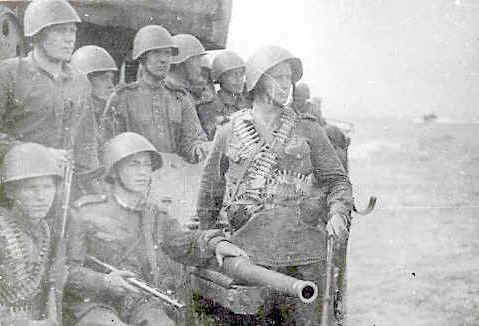
Fighters of the 355 th Separate Marine Battalion before the 14.08.1945 landing
2 Far East Front
The troops of 2 of the Far Eastern Front were approaching the center of Manchuria from the north. By the end of 17 in August, the 2-I Red Banner Army in the area of Sunu UR completed the rout of the grouping of the 4-th separate army of the Japanese, taking about 20 thousand people as prisoners. After that, the mobile units quickly moved south. 20 August 74-I tank brigade broke into the city of Beian.
The forces of the 15 Army, taking the city of Fujin, attacked Jiamusi. The Japanese, in order to delay the movement of our troops and ships of the Amur Flotilla, blew up the railway bridge across the Sungari River, set off a forest along the river and sank several barges. However, this could not stop the Soviet troops. Ships of the Amur Flotilla in the area of Jiamusi landed troops. On August 17, our troops, with the support of artillery, attacked the Japanese in Jiamusi from different directions. Parts of the 134 Japanese Infantry Division attempted to destroy the city by blasting and setting fire to buildings. But the rapid advance of our troops prevented the full implementation of this plan. After the capture of Jiamusi, the troops of the 15 Army moved to Harbin. The 5 Rifle Corps attacked Pain.
Thus, during eight days of continuous fighting, the Soviet troops overcame major water obstacles - the Argun, Amur and Ussuri rivers, the Great Khingan mountain range, smashed the enemy's powerful long-term defense. The flanks of the Soviet fronts almost closed. Soviet troops from different directions quickly approached the center of Manchuria. The troops of the Trans-Baikal Front reached the Kalgan area, joining the Chinese forces, cutting off the Kwantung Army from the Japanese troops in other parts of China. And the forces of 1 of the Far Eastern Front and the Pacific Fleet took the ports of North Korea, cutting off the Kwantung Army from the Japanese islands.
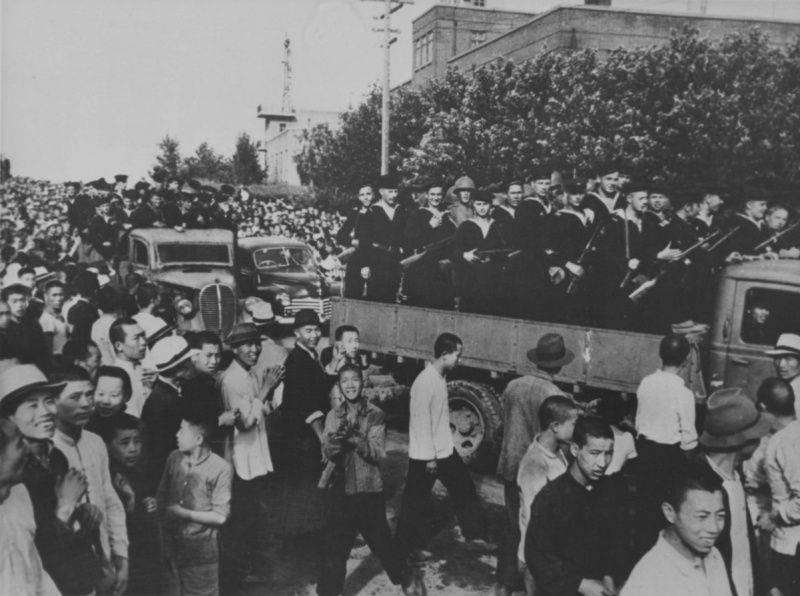
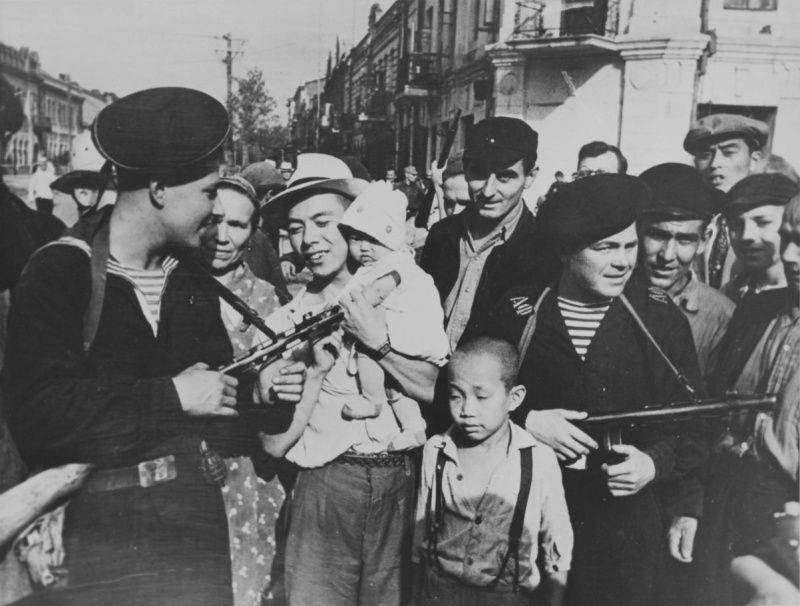
Residents of the city in Manchuria greet sailors of the Amur Flotilla
The end of hostilities
The Kwantung Army was cut off from Japanese troops in other parts of China and in Japan. The Japanese army suffered heavy losses in people and equipment and lost almost all the pre-prepared lines of defense. In the central regions of Manchuria, where the remnants of the Japanese army had withdrawn, there was no long-term defense. To continue the resistance was meaningless. Therefore, on August 17, the command of the Kwantung Army appealed to the Soviet command to stop further hostilities.
Marshal of the Soviet Union A. M. Vasilevsky declared on August 17: “I propose that the commander of the Kwantung Army with 12 hours on August 20 cease all military operations against the Soviet troops on the whole front, fold weapon and surrender ... As soon as the Japanese troops begin to surrender their weapons, the Soviet troops will cease hostilities. "
In 17 hours of 17 August, the radio station of the reconnaissance department of the 1 of the Far Eastern Front received a radio message from the headquarters of the Kwantung Army, which reported on the surrender to the troops of the order of surrender and the cessation of hostilities. All units of the Kwantung Army were to immediately stop the battle and lay down their arms.
However, after that, the main part of the Japanese troops continued to resist. Only in some areas of the front - in the area of Pain on the right wing of the 1 of the Far Eastern Front, in the offensive zone of the 25 Army and on the left wing of the Trans-Baikal Front, in the area of Bukhedu, the Japanese surrendered en masse. In this regard, the Soviet headquarters ordered the cessation of hostilities in those sectors where Japanese forces lay down their arms and surrender.
To complete the defeat of the enemy, the Soviet command took measures to increase the pace of the offensive. Army mobile units were formed, which included tank battalions, artillery anti-tank batteries and rifle subunits in motor vehicles. In each army there were several such units. In the 17 Army of the Transbaikal Front, three mobile detachments were formed, in the 39 Army, seven. However, the mobile units were not always able to move quickly forward. Torrential rains ruined roads, caused floods of rivers, made the terrain impassable, and in some places impassable.
The Japanese command to 10 hours 18 August brought to his troops the order of surrender. But this time the Japanese did not give up everywhere. On this day, before the troops of the Trans-Baikal Front, the remnants of the Hailar Fortified Area garrison in the number of 2200 people capitulated. In the Zhalantun area, 2 was thwarted by thousands of Japanese soldiers. In the offensive zone of the 2-th Red Banner Army of the 2-th Far Eastern Front near Sunu, the 123-I Infantry Division led by its commander surrendered. The troops of the 15 Army took the cities of Tanyuan and Sanxing. The troops of 1 of the Far Eastern Front developed an offensive against Harbin and Jilin.
To speed up the surrender of the enemy army, the Soviet command decided to land airborne troops in the largest cities of Manchuria. On August 19, an airborne assault force from an 225 man was landed in Mukden, and an 200 man was planted in Changchun.
On August 19, the Chief of Staff of the Kwantung Army, Lieutenant General Hikosaburo Hata, was brought from Harbin to the headquarters of the 1 of the Far Eastern Front. He was accepted by marshals Vasilevsky and Meretskov. Vasilevsky warned Khat to let the Japanese troops surrender in an organized manner with their officers. Khata agreed with the demands of the Soviet command and asked the Japanese soldiers to leave weapons in a number of cities in China and Korea before the approach of the Soviet troops due to the “insecurity of the population”. The Japanese were afraid that the Chinese and Koreans, who hated the invaders, would be cut them out. Marshal Vasilevsky, through General Hata, presented an ultimatum to the commander of the Kwantung Army, Otozo Yamada, demanding that the action no later than the 12 20 hours of August 1945 be ceased.
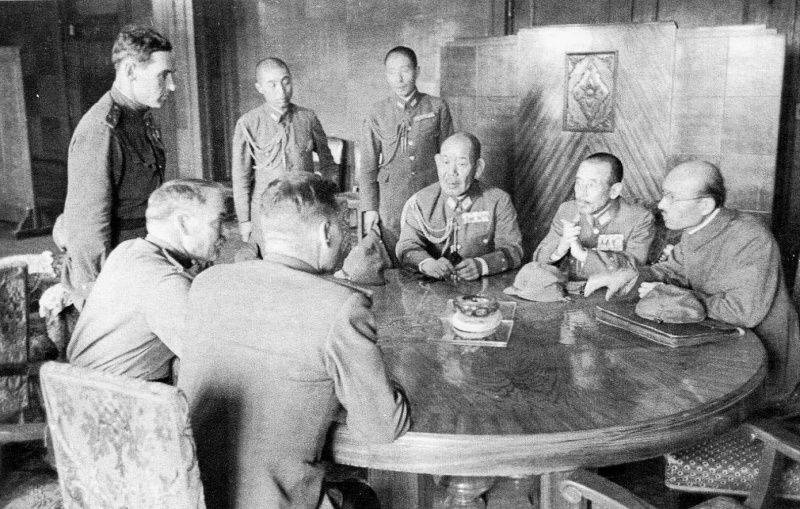
Negotiations of the Soviet command with representatives of the headquarters of the Kwantung Army on the conditions for the surrender of Japanese troops
The process of putting the Kwantung Army accelerated significantly. The left-wing 36 Army of the Trans-Baikal Front, August 19, occupied Qiqihar, capturing up to 6 thousands of enemy soldiers and officers. On the main line, the advanced units of the 6 Guards Tank Army 20 of August occupied Mukden and went to Changchun. To speed up the seizure of the Liaodong Peninsula with the ports of Port Arthur and Dalny here, airborne assault forces were thrown out on 22 in August. The Japanese garrison of Port Arthur was quickly disarmed. On August 24, a part of the 6 Guards Tank Army arrived at Port Arthur by rail. Then, units of the 39 Army appeared on the Liaodong Peninsula. They occupied the cities of Yingkou, Gayping and Andong.
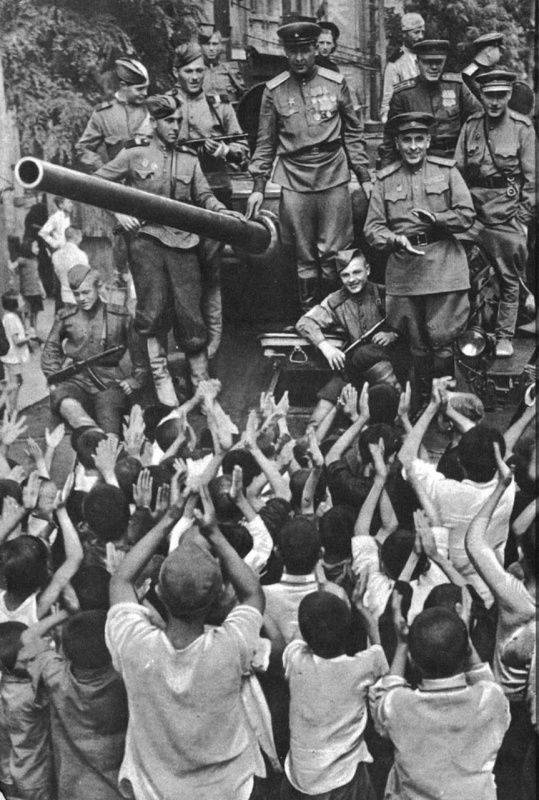
The population of the Chinese city of Dalian (Far) joyfully meets the tank crews of the 7 th mechanized corps of the 6 th Guards Tank Army
In the offensive zone of the 1 of the Far Eastern Front 18 of August, an airborne assault force landed in Harbin, and in August 19 - in Jilin. 20 August the advance units of the 25 Army entered Jilin, Dunhua. On the same day, the advanced troops of the 2 Far Eastern Front aboard the ships of the Amur Flotilla were landed in Harbin. Soon there came part of the 1 th Red Banner Army. The troops of the 25 Army continued to liberate North Korea. August 21 in the port of Wonsan assault force of the Pacific Fleet landed. The Japanese garrison laid down their arms.
While our armies occupied central Manchuria, the offensive also continued on southern Sakhalin. Simultaneously with the onset of the 79 Infantry Division, the Soviet command organized the landing of several landings on the coast. On August 16, the landing party consisting of one battalion of the 113 Infantry Brigade and Marine Battalion with the support of ships and aircraft of the Northern Pacific Flotilla occupied the city of Toro. On August 20, the landing force of the 113 th brigade took the port of Maoka. Meanwhile, units of the 79 Infantry Division completed the breakthrough of the Kotonskogo fortified area and continued to move south. The organized resistance of the enemy collapsed. 25 August our troops occupied the last major centers of South Sakhalin. The landing in the port of Otomari (Korsakov) on August 25, through which the evacuation and removal of material assets of the Japanese army were mainly carried out, was the last act of the fighting on the island. As a result of the South Sakhalin operation, more than 18 thousand Japanese soldiers and officers were captured.
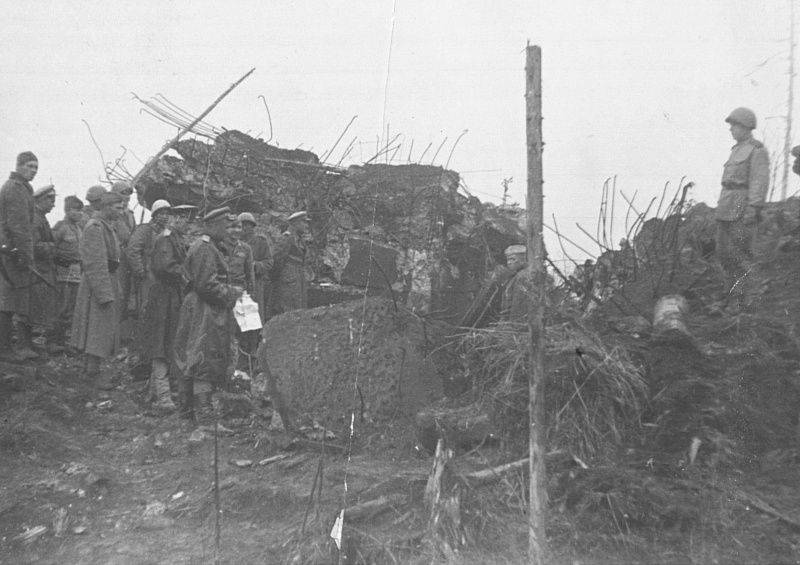
Japanese bunker, destroyed by Soviet sappers in the area of the Kharamitogsky UR on Sakhalin
The successful course of the hostilities in Manchuria, Korea, and South Sakhalin allowed the Soviet command to proceed with the liberation of the Kuril Islands. The task of mastering the Kuril Islands was entrusted to the command of the Kamchatka defensive region (Major General A. R. Gnechko) as part of the 2 of the Far Eastern Front. The Kamchatka defensive area included: the 101-I Rifle Division, the Marine Corps battalion, howitzer artillery regiment and the 128-I mixed air division (78 aircraft). The operation also involved ships of the Petropavlovsk naval base (captain of the 1 rank DG Ponomarev) and the 2 th separate bomber regiment of naval aviation. As there was an acute shortage of special landing ships, merchant ships were attracted to the landing operation.
On the Kuril Islands, the Japanese had significant forces, units of the 27 Army: the 91 Infantry Division (on Shumshu Island, Paramushir, Onekotan), the 89 Infantry Division (on Iturup Island, Kunashir, the Small Kuril Ridge), units 11-th tank regiment (Shumshu, Paramushir), 31-th air defense regiment (Shumshu), 41-th separate mixed regiment (on Matua), 129-I separate infantry brigade (on Urup). There are more than 80 thous. Soldiers and officers. The northern group was commanded by Lieutenant-General Tsutsumi Fusaki.
The most powerful fortifications were on Shumshu Island, located just 6,5 miles off the southern coast of Kamchatka. The 73 Infantry Brigade of the 91 Infantry Division, the 31 Infantry Regiment, the Fortress Artillery Regiment, the 11 Tank Regiment (without one company), the naval base of Kataoka, the airfield command and various separate units were stationed there. Shushma garrison made 8,5 thousand people, more than 100 guns, 60 tanks. There were several dozen pillboxes and pillboxes, more than 300 closed machine-gun points, numerous underground shelters for troops and military equipment. Most defenses were connected by underground passages into a single defensive system.
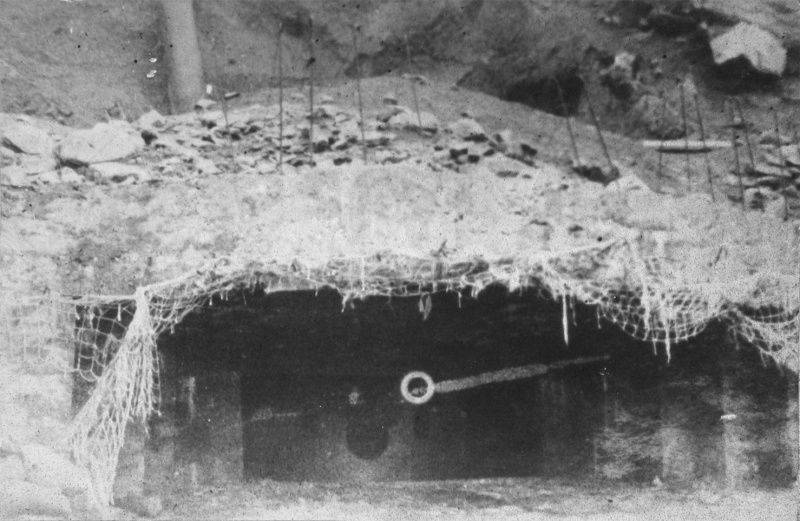
One of the Japanese coastal bunkers that covered the Kataoka naval base on Shumshu Island. It is equipped with a 76-mm naval gun Type 41
The Kuril operation began on August 18 landing troops on about. Shumsh. The Japanese resisted stubbornly, but suffered defeat. 23 August, the Japanese garrison of the island, despite its superiority in manpower and equipment, capitulated. More than 12 thousand people were taken prisoner. 22 — 28 August, Soviet troops landed on other islands of the northern part of the ridge (up to and including Urup). On August 23, without any resistance, the powerful garrison of the island of Paramushir surrendered (about 8 thousand people). 23 August - 1 September were occupied by the islands of the southern part of the ridge. In total, over the 50 of thousands of Japanese soldiers and officers were disarmed and captured on the Kuril Islands.
From 24 August to early September 1945, Soviet troops completed the destruction of the remaining centers of resistance of the enemy. The liberation of North Korea was completed. 24 August Soviet paratroopers occupied the main city of North Korea, Pyongyang. On August 25, troops of the 25 Army advancing along the east coast of the Korean Peninsula occupied the port of Genzan.
Results
The Soviet armed forces entered a new page in the glorious chronicle of Russian victories. Military operations at the Manchurian Theater did not last long, but in their scope and skill, in terms of the results achieved, they are among the most outstanding operations of the Great Patriotic War and World War II.
During the fifteen-day fighting, the Japanese army lost more than 880 thousand people killed, wounded, missing and captured. The complete defeat of the Kwantung Army became a model of genuine lightning war carried out by the Soviet Army. The operation showed the increased power of the Soviet empire and its armed forces. The Japanese army, which had an enormous military experience, with disciplined and brave soldiers who knew the theater of military operations, with a powerful defensive system that had been improved for years, was immediately defeated!
The strategic plan of the operation, using powerful flank attacks on converging directions in the center of Manchuria, combined with an auxiliary strike in the north, fully justified itself. The Japanese command did not expect the main blows of the Soviet Army in these areas at all. For the Japanese, the appearance of the 6 Guards Tank Army at the passes of the Great Khingan, as well as the output of the troops of the 1 Far Eastern Front in the Mudanjiang region through the mountains, swamps and taiga, was a complete surprise.
A successful breakthrough of the band of fortified areas was facilitated by the troops arriving from the German front and having a vast experience of breaking through the powerful defense of the Wehrmacht. During the storming of fortified areas, individual resistance centers and strongholds, assault groups were widely used, and they actively used artillery and aircraft. With the development of the offensive in depth and the pursuit of the enemy, specially formed mobile units were used. Due to the great saturation of the Soviet fronts with armored and mechanized units, the use of ships of the Amur Flotilla and the Pacific Fleet, and landing of airborne troops, Soviet fronts waged a maneuverable war in Northeast China.
Our troops occupied Northeast China, North Korea. The success of the Manchurian operation allowed the liberation of South Sakhalin and the Kuril Islands in the shortest possible time. The defeat of the Kwantung Army and the loss of the military-economic base in Northeast China and North Korea were decisive factors that led to the surrender of the Japanese Empire. Deprived of the forces and capabilities to continue the war, the Japanese military and political leadership of 2 in September of 1945 surrendered. The Second World War was over.
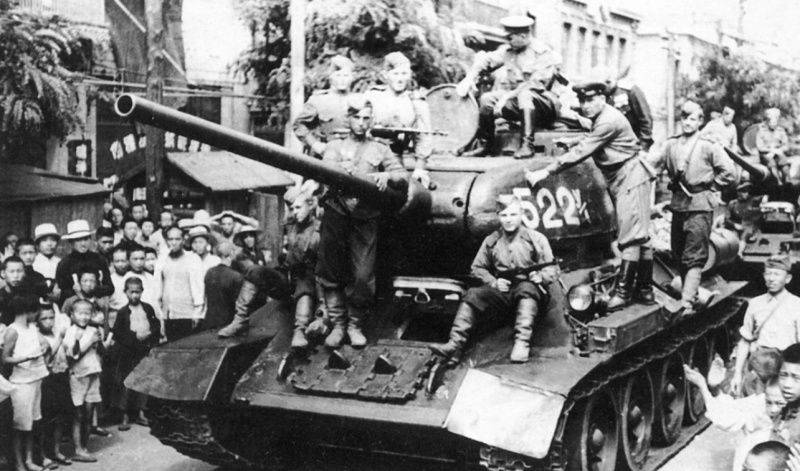
A column of T-34-85 7 tanks of the 6 Mechanized Corps of the Guards Tank Army with troops on the streets of the Chinese city of Dalian (Far)
Sources:
Alexandrov A. The Great Victory in the Far East. August 1945 of the year: from Transbaikalia to Korea. M., 2004.
Asmolov K. Victory in the Far East // The Great Slandered War-2. We have nothing to repent! M., 2008.
Bagrov V.N., Yuzhno-Sakhalinsk and Kuril operations (August 1945). M., 1959.
Vasilevsky A.M. A matter of a lifetime. M., 1978. // http://militera.lib.ru/memo/russian/vasilevsky/index.html.
History Great Patriotic War of the Soviet Union 1941-1945 (in 6 volumes). M., 1960-1965.
The history of the war in the Pacific (in five volumes). M., 1957, 1958. // http://militera.lib.ru/h/istoriya_voyny_na_tihom_okeane/index.html.
The history of the Second World War 1939-1945's. (in 12 volumes). M., 1973-82.
Campaign war in the Pacific. M., 1956. // http://scilib.narod.ru/Military/PacificWar/contents.htm.
Fuller JFH, World War II 1939-1945. Strategic and tactical review. M., 1956. // http://militera.lib.ru/h/fuller/index.html.
Hattori Takusiro. Japan in the war. 1941-1945 M., 2000.
Shirokorad A. B. Far Eastern finale. M., 2005.
http://waralbum.ru.
- Alexander Samsonov
- The Soviet Union saved the world from "a decisive battle in Japan"
US offensive in the Pacific and Southeast Asia on 1945
Battle of Okinawa. Japan invasion plans
Moscow decides to oppose Japan
Stalin restores the military-strategic position of Russia in the Far East
The combat potential of the Kwantung Army
Manchu Strategic Offensive
Breakthrough of the Kwantung Army Defense
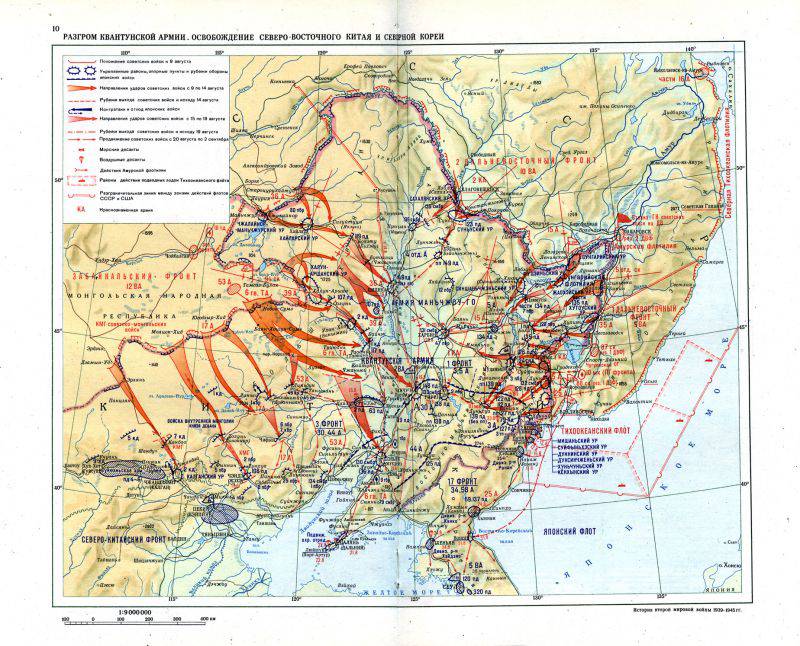
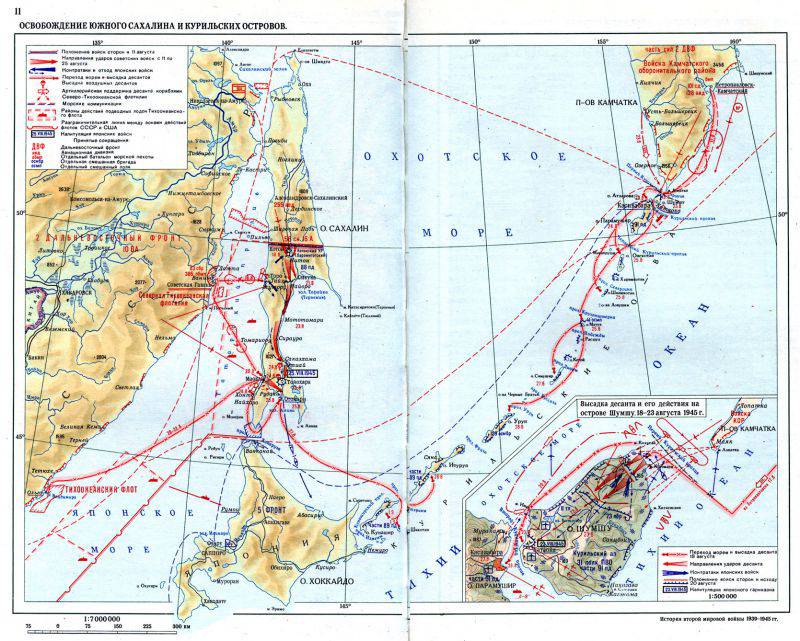
Information